Art
The Death of Political Cartooning—And Why It Matters
Many nominally democratic political regimes practice de facto censorship in regard to material criticizing their populist rulers.

Six years ago, on January 7th, 2015, two brothers armed with Kalashnikov rifles assaulted a building on Rue Nicolas-Appert in Paris, where they killed a maintenance man named Frédéric Boisseau and forced their way into the second-floor offices of the satirical magazine Charlie Hebdo. They asked for four cartoonists, by name, and executed each of them. They also killed four other journalists, a bodyguard assigned to protect one of the cartoonists in the event of just such an attack, police officer Ahmed Merabet, and a friend of one of the cartoonists. Following a nihilistic two-day crime spree, the brothers were killed in a hail of police bullets outside a printworks north-east of Paris.
The ghastly murders at Charlie Hebdo shocked the world. Yet while the scale and violence of the incident were unprecedented, such attacks against cartoonists are hardly unknown. Throughout history, cartoonists have been jailed, kidnapped, tortured, exiled, and murdered. Ostensibly, the Charlie Hebdo cartoonists were killed for drawing pictures of the prophet Muhammad. (Two days after the murders, an al-Qaeda cell in Yemen claimed to have engineered the attack. And a surviving journalist named Sigolène Vinson reported that one of the killers instructed her to convert to Islam, and shouted Allahu Akbar!) It’s a pattern similar to other historical incidents in which cartoonists have been targeted: The victims made a joke at the expense of those who couldn’t take one.

In the aftermath, there was a huge outpouring of support for Charlie Hebdo. The slogan “Je suis Charlie” (I am Charlie) appeared everywhere. Millions marched in the streets, and heads of state locked arms and strode defiantly down the Boulevard Voltaire in support of free speech. The “blasphemous” cartoons that had displeased al-Qaeda were reprinted in other Western countries, and Charlie Hebdo’s surviving staff sold eight million copies of a follow-up edition depicting Muhammad crying over the slain. Seen in isolation, it seemed as if Western politicians and journalists were united in defense of liberty and free expression, even in the salty, provocative form favored by cartoonists.
But in truth, political cartooning is in decline—and not simply because of the dramatic (and very real) threats posed by religious fanatics. Many nominally democratic political regimes practice de facto censorship in regard to material criticizing their populist rulers. Then there’s the collapse of print media, the rise of new codes of political correctness, social-media mobs, and the greater competition for audience presented by Netflix and other online media. My craft has a glorious history, and has shaped the fates of empires. Yet many young people won’t be mourning the slow death of editorial cartooning because they are no longer aware that the medium even exists.
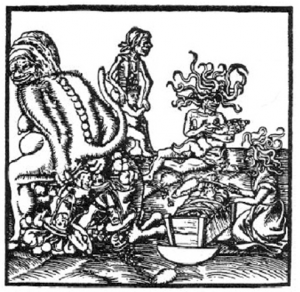
Some trace the birth of cartooning back to Christian reformer Martin Luther, whose blockbuster successes on the newly invented printing press helped pioneer the distribution of woodcut sketches lampooning the Catholic Church. Luther knew that many people who looked at his works were barely literate, so he recruited artists to complement them with pictures that spoke for themselves. In one (still) shocking 1545 image, The Birth and Origin of the Pope, German Renaissance painter and printmaker Lucas Cranach depicted the devil defecating out Pope Leo X. In the centuries to come, many such satirists would pay with their lives (though not Cranach, who had powerful political allies, and lived till the ripe age of 81).
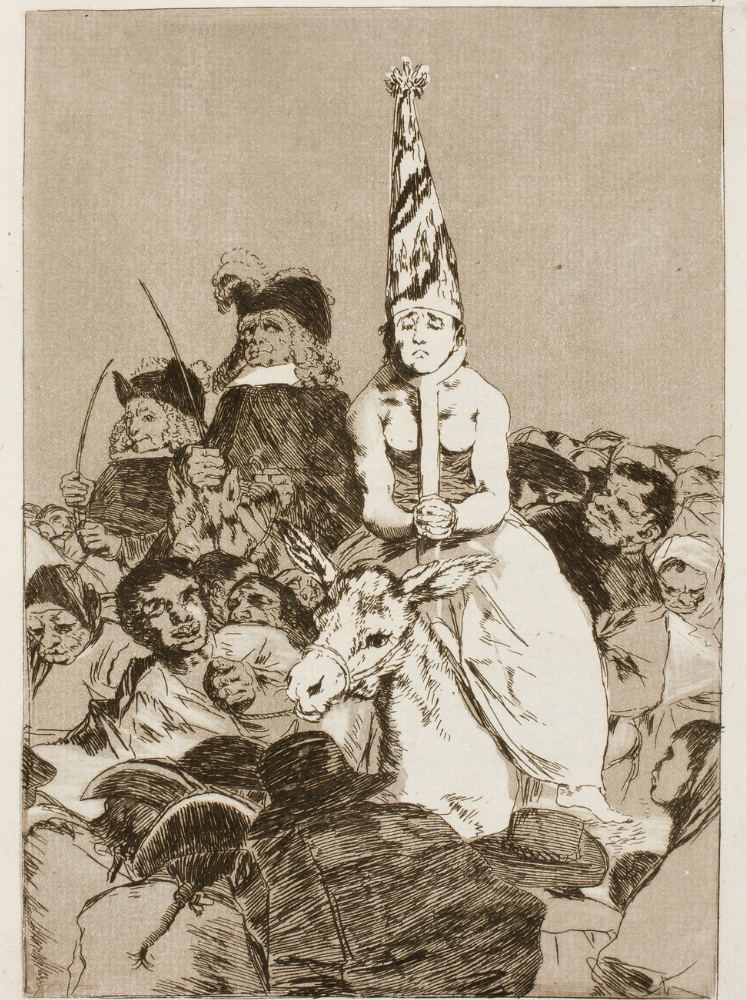
In Spain, the Tribunal of the Holy Office of the Inquisition kept up operations till the early 19th century. Its demise was sped along by Spanish master Francisco Goya, whose famous Los Caprichos etchings assailed the spirit of madness and social panic wrought by the Inquisition. Meanwhile, in the political sphere, cartoonists on all sides of the French Revolution (and its Napoleonic aftermath) became powerful cultural combatants. On one hand, Parisian cartoonists hastened the demise of Louis XVI and Marie Antoinette by depicting them as indulgent and sexually licentious. Yet Napoleon fared little better, at least among foreign artists such as English caricaturist James Gillray, who gleefully portrayed the emperor as a lunatic. Gillray, Napoleon lamented late in life, “did more than all the armies of Europe to bring me down.” (Ironically, Gillray died in June, 1815, just days before Napoleon’s final defeat at Waterloo.)
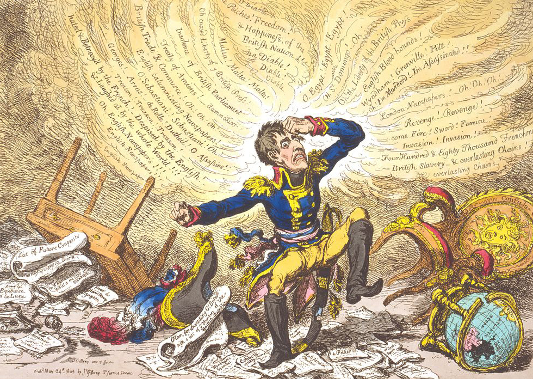
Following Napoleon’s fall, the subsequent Bourbon Restoration, and the July Revolution of 1830, Europe’s caricature artists were still at it—including caricaturist and publisher Charles Philipon, whose depiction of King Louis Philippe I as a pear (La Poire) stands as one of the most famous political cartooning images in the craft’s history. An enraged Louis orchestrated a massive crackdown against the press, including against Philipon himself, who defended himself during his trial by drawing the king’s face, and then three additional sketches displaying how the king’s likeness slowly morphs into that of a pear. “Can I help it if His Majesty’s face is like a pear?” he asked his prosecutors. Philipon was convicted of “contempt of the king’s person” and was briefly imprisoned. But the pear would endure as a symbol of revolution.

The first influential cartoon published in an American newspaper has traditionally been credited to Benjamin Franklin, who drew his famous serpent divided into eight parts with the legend Join, or Die—the message being that fellow colonists must band together to repel the enemy forces then threatening their territory. Long after Franklin’s death, the image would be dusted off for reuse by supporters of American unity.

Thomas Nast, whom many consider to be the greatest editorial cartoonist of all time, rose to prominence during the Civil War. Still in his early 20s, the young German immigrant began producing such arresting pro-Union material that Abraham Lincoln—flipping Napoleon’s rueful commentary about James Gillray on its head—referred to Nast as “our best recruiting agent.”
During the national election of 1864, conducted amidst the Civil War, the Democrats pushed a platform of reconciliation with the slaving south. In response, Nast created his famous Compromise with the South cartoon, depicting an injured union soldier, bowing his head and lifelessly shaking hands with a victorious confederate who stands atop the grave of a fallen Yankee, with Lady Liberty weeping in the foreground. The epitaph on a tombstone reads “In memory of the Union heroes who died in a useless war.” Nast’s lurid but masterful image created a sensation, and showed how politically powerful the cartooning medium could be in an age of mass newspaper readership. Two months later, Abraham Lincoln defeated the Democrat candidate, George McClellan, to secure a second term.

In the decades following the war, Nast would continue to elevate the medium to high art. In 1871, he began an ongoing series for Harper’s Weekly attacking the corruption of Tammany Hall, the Democratic political machine that controlled New York politics. Nast so mercilessly lampooned William M. “Boss” Tweed as the machine’s ringleader, that Tweed was heard to rage, “Stop them damn pictures! I don’t care a straw for your newspaper articles. My constituents can’t read. But they can’t help seeing them damn pictures!”
Eventually, Tweed was convicted of money laundering. (He attempted to escape justice by absconding to Spain, but was soon apprehended by Spanish officials, who reportedly recognized him with assistance from Nast’s cartoons.) As for Nast himself, he’d go on to conceive of the elephant as a symbol for the Republican party, popularize the use of the donkey for the Democrats, and help create the modern image of Santa Claus that Americans have come to love.
In the 20th century, radio and television would replace print as the public’s preferred source for news. And so the grand and intricate style of cartooning employed by newspapers and magazines during the 19th century was no longer sustainable. These were replaced by smaller and simpler cartoons, which allowed for more advertising space and faster turnaround times. But even within these constraints, brilliant cartoonists continued to emerge as influential provocateurs. In the lead-up to WWI, American artist Art Young was tried twice under the country’s Espionage Act for “conspiracy to obstruct enlistment.” One of his images portrayed the war as devilish chaos, cheered on by ignorant and cynical politicians, capitalists, religious officials, and journalists.
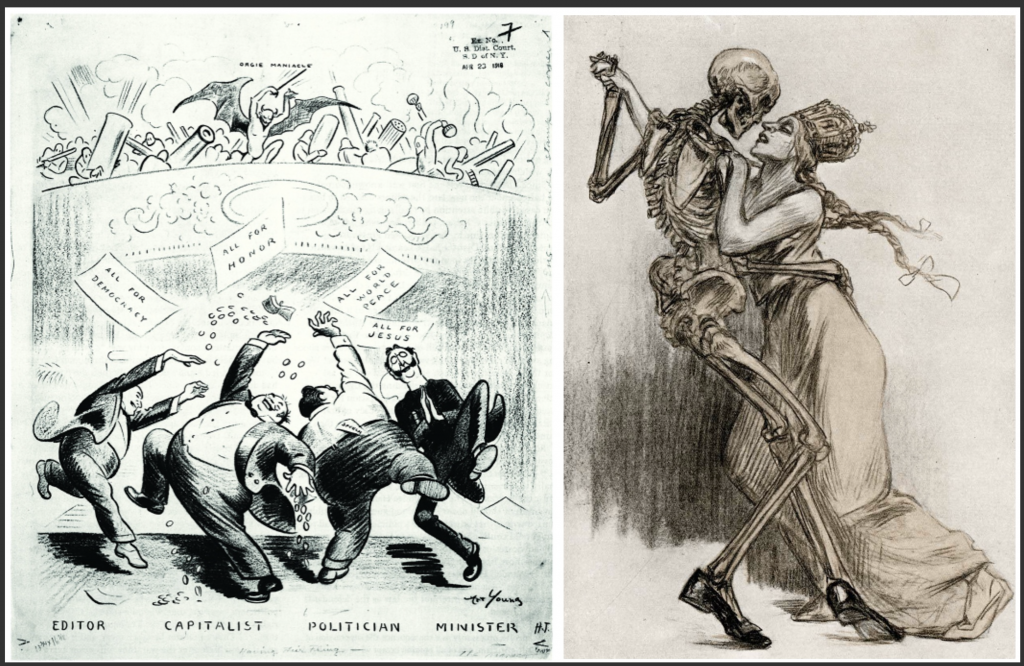
During the same era, Dutch cartoonist Louis Raemaekers was charged with the crime of endangering Dutch neutrality with his cartoons depicting German militarism. In one of his most famous pieces, a woman representing imperial Germany is shown being drawn into an intimate dance with Death himself.
Tyrants and demagogues of whatever stripe, generally being both cruel and bombastic, have always made easy targets for cartoonists. This of course includes the worst of the lot, Adolf Hitler, who was mocked by (among many) English cartoonist David Low. Indeed, the Nazis were so infuriated by Low that he made it into the Sonderfahndungsliste G.B. (better known in English as the “Black Book”)—the list of prominent British figures slated to be arrested if the Germans ever managed to invade and occupy Great Britain.
Communist tyrants were the subject of caricature as well. And so, too, were notorious anti-communists, such as US Senator Joseph McCarthy. Indeed, long-time Washington Post cartoonist Herbert Block is credited with coining the term “McCarthyism” in one of his 1950 cartoons. And his later work skewering Richard Nixon during the Watergate scandal earned him a Pulitzer Prize, alongside the more famous Bob Woodward and Carl Bernstein.
Herblock (as he often was known) died in 2001, and so wasn’t alive to witness the continued decline of his trade in the 21st century. Yes, editorial cartoons still exist (including at the Washington Post, which runs a cartooning syndication service featuring eight artists). But their influence is nowhere near what it once was. And one of the few times when they still enter the public consciousness is when they attract the ire of fanatics or tyrants—which still happens in repressive countries such as Syria, Iran, Turkey, Venezuela, China, and Russia; or in free countries such as France that are attacked by terrorists.
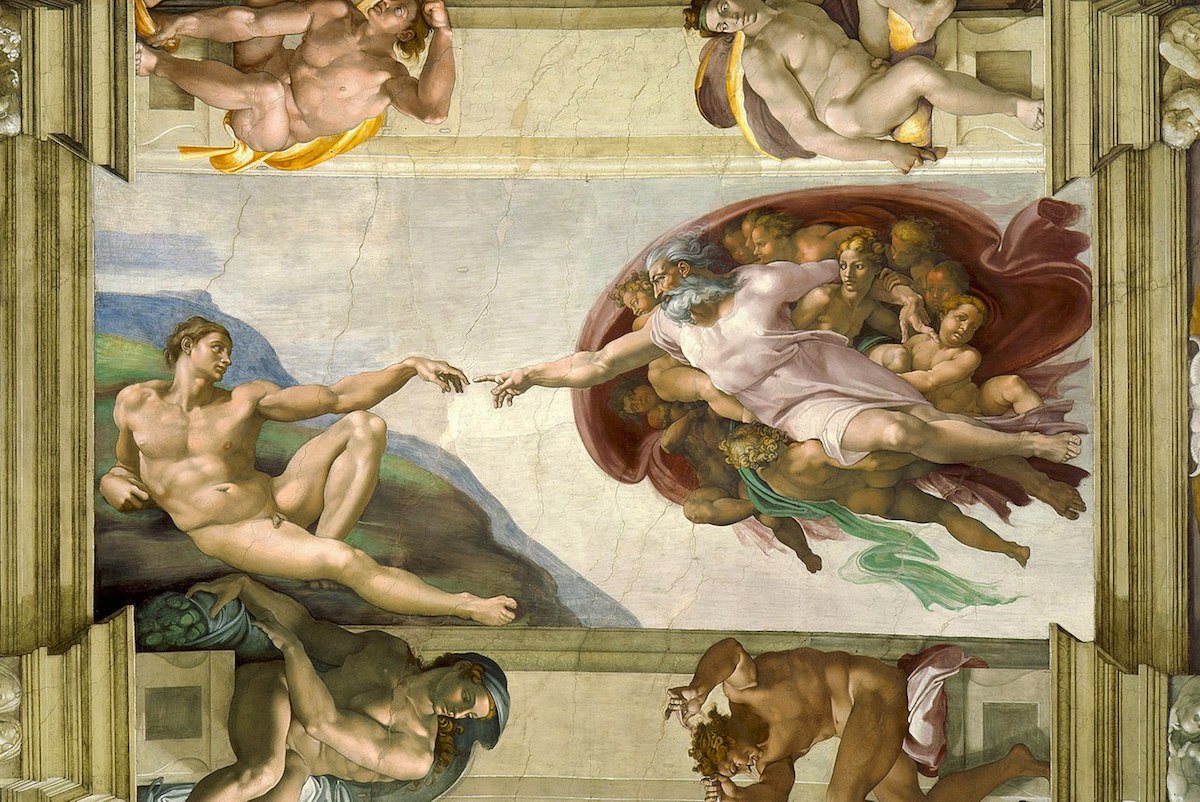
In his 2013 book The Art of Controversy: Political Cartoons and Their Enduring Power, author Victor S. Navasky explained that the visual stimulus of a cartoon hits our brains in the thalamus, “which in turn passes the information to the region of the brain called the amygdala, the brain’s ‘fear center.’” The effect is to provoke a more rapid emotional response than would be possible through text. By amplifying this effect through caricature, exaggeration, and mockery, cartoonists—like propagandists (and sometimes the line between the two can be blurry)—can supercharge these mental phenomena. In fact, Navasky describes research to the effect that our brains “react more quickly to caricatures than photos of real faces,” which some neuroscientists call a form of superstimuli.
For a 19th-century newspaper reader, this might have been the only superstimuli the media could provide them. But we are now living in an era of mass overstimulation, especially through video, a medium with which old-school cartoonists never had to compete. A well-liked cartoon on the cover of a newspaper might have once been a source of discussion for days. But that effect is impossible to duplicate in the current age of social media. Sharing even the best cartoon on social media is akin to throwing a chicken into an alligator pit: It will be instantly consumed, digested, and forgotten.
The only exceptions occur when cartoonists get negative publicity—as in 2018, when Australian cartoonist Mark Knight received blowback for his cartoon depicting tennis great Serena Williams having a mid-match meltdown at the US Open. Cries of racism and sexism rained down from watchdog groups, athletes, and celebrities. The furor even forced an investigation by the Australian Press Council (which eventually exonerated the cartoonist and his publisher, though by that time, of course, everyone had moved on). “The cartoon about Serena is about her poor behavior on the day, not about race. The world has just gone crazy,” Knight said afterwards.
In April 2019, the international edition of the New York Times published a political cartoon by Portuguese artist António Moreira Antunes that was seized upon by critics as anti-Semitic. The cartoon portrayed a recently re-elected Benjamin Netanyahu as a seeing-eye dog, leading a blind President Trump, as an obvious metaphor for the relationship between the two leaders.

In response to the outcry, the Times immediately discontinued all editorial cartoons in their international edition (they hadn’t run cartoons in their domestic edition since 1958) and dismissed their two in-house cartoonists, Patrick Chappatte and Heng Kim Song, neither of whom had anything to do with the offending piece. (“Hey this is new. Did we just invent preventive self-censorship?” Chappatte asked in his excellent TED Talk on the subject.) For his part, António (as he is known professionally) denied he had worked with any racist intent, and that people should not accept the idea that “any criticism of Israel is anti-Semitism.”
More recently, we’ve witnessed the self-cancellation of Susan Miller Warden and Jeanne Miller Wood, co-owners of the Washington Missourian newspaper, who resigned after their 90-year-old father, Bill Miller, the paper’s editor and publisher, published a cartoon by Tom Stiglich attacking the idea of defunding the police.

“We believe it was racist and in no circumstance should’ve been published” the sisters wrote. Their father also apologized for his “poor judgment,” and called the cartoon “racially insensitive.” The paper promised readers they would “discontinue using cartoons by this particular cartoonist.” (Stiglich, no stranger to controversy, once remarked about his work, “Any time that I include a minority, some readers will automatically scream ‘that’s racist.’ That does tend to get old.”)
And lest we imagine that humorless outrage is limited to the left side of the political spectrum, consider veteran Canadian cartoonist Michael de Adder from Brunswick News Inc., and Rob Rogers from the Pittsburgh Post-Gazette, both of whom created pointed anti-Trump cartoons that did not sit well with their publishers. De Adder lost his job in 2019 after creating the cartoon that appears below. Rogers also was fired, despite the fact that he’d been with the Post-Gazette for 25 years.
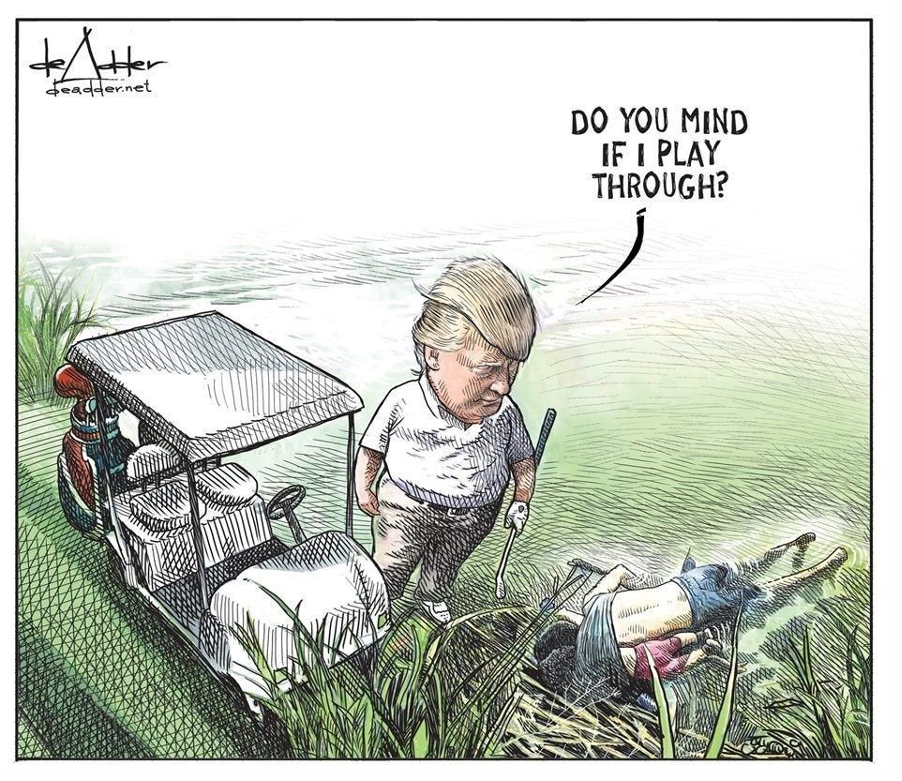
It’s estimated that at the start of the 19th-century, there were about 2,000 editorial cartoonists plying their trade in print across the United States. As far as I can tell, that number now hovers around 30. The few cartoons that do remain in circulation are usually picked up on the cheap from syndicates (such as the above-referenced Washington Post). These syndicates act as sales agents for cartoonists, and are eager to sell the same pieces to as many publications as possible. And the more broad and generic the cartoon, the better the sales. This keeps the art form focused on the national or international scene, endlessly sending up the same stale left-vs-right dynamic, with little commentary on local issues. The majority are facile and forgettable—a perfect fit for the corporate owners of the last newspapers standing.
Considering that cartoons and cartoonists are often the first to go when fascists gain power, it is sad that we here in the West—where we remain free to publish what we want—seem determined to watch them go extinct through a combination of cancel culture, indifference, and economic factors. But the fanatics are far from indifferent: When French middle school teacher Samuel Paty was beheaded in October, it was allegedly because he’d had the temerity to display the controversial Charlie Hebdo cartoons to his students as a visual aid in a discussion of freedom of expression. He had warned his Muslim students about the images in advance, offering them the chance to opt out of the session if they preferred. The lesson caused an uproar anyways, and in the end his precautions made no difference to those who feel murder is a justifiable response to drawings.
“Against the assault of laughter,” wrote Mark Twain, “nothing can stand.” This insight remains as true today as ever, and helps explain why the right to ridicule is one of the first rights that freedom’s enemies seek to extinguish. The job of the cartoonist is to hold up a mirror and allow society to get a good look at itself, perchance to laugh in a spirit of self-recognition. I fear for any society that decides it cannot be roused to do so.






